Strategic Analysis of Lidl's Expansion into the Mexican Market
VerifiedAdded on 2022/11/13
|18
|5508
|196
Report
AI Summary
This report provides a strategic analysis of Lidl's potential expansion into the Mexican market. It begins with an executive summary and introduction outlining the challenges and opportunities in the international supermarket industry. The report then focuses on choosing Mexico as the target market, supported by a PESTLE analysis that evaluates the political, economic, social, technological, legal, and environmental factors. A detailed industry analysis using Porter's Five Forces model assesses the bargaining power of suppliers and buyers, the threat of competition and substitution, and the threat of new entrants. The VRIO framework is then applied to evaluate Lidl's resources and capabilities, determining its competitive advantages. The analysis concludes with a recommendation for a joint venture as the most suitable mode of entry into the Mexican market, and a comprehensive conclusion summarizing the key findings and recommendations. The report references relevant literature and includes an appendix with supporting data and analysis.
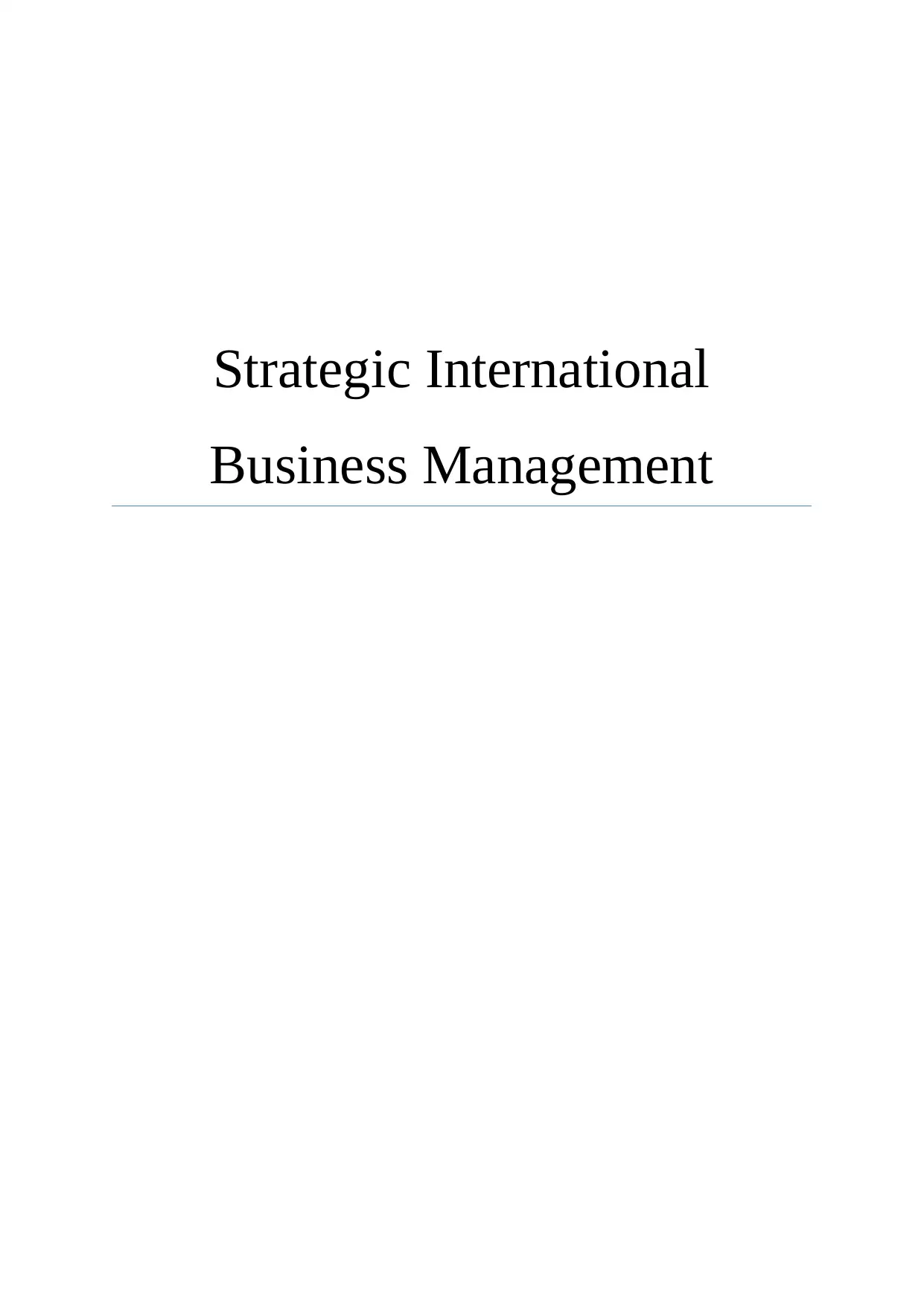
Strategic International
Business Management
Business Management
Paraphrase This Document
Need a fresh take? Get an instant paraphrase of this document with our AI Paraphraser
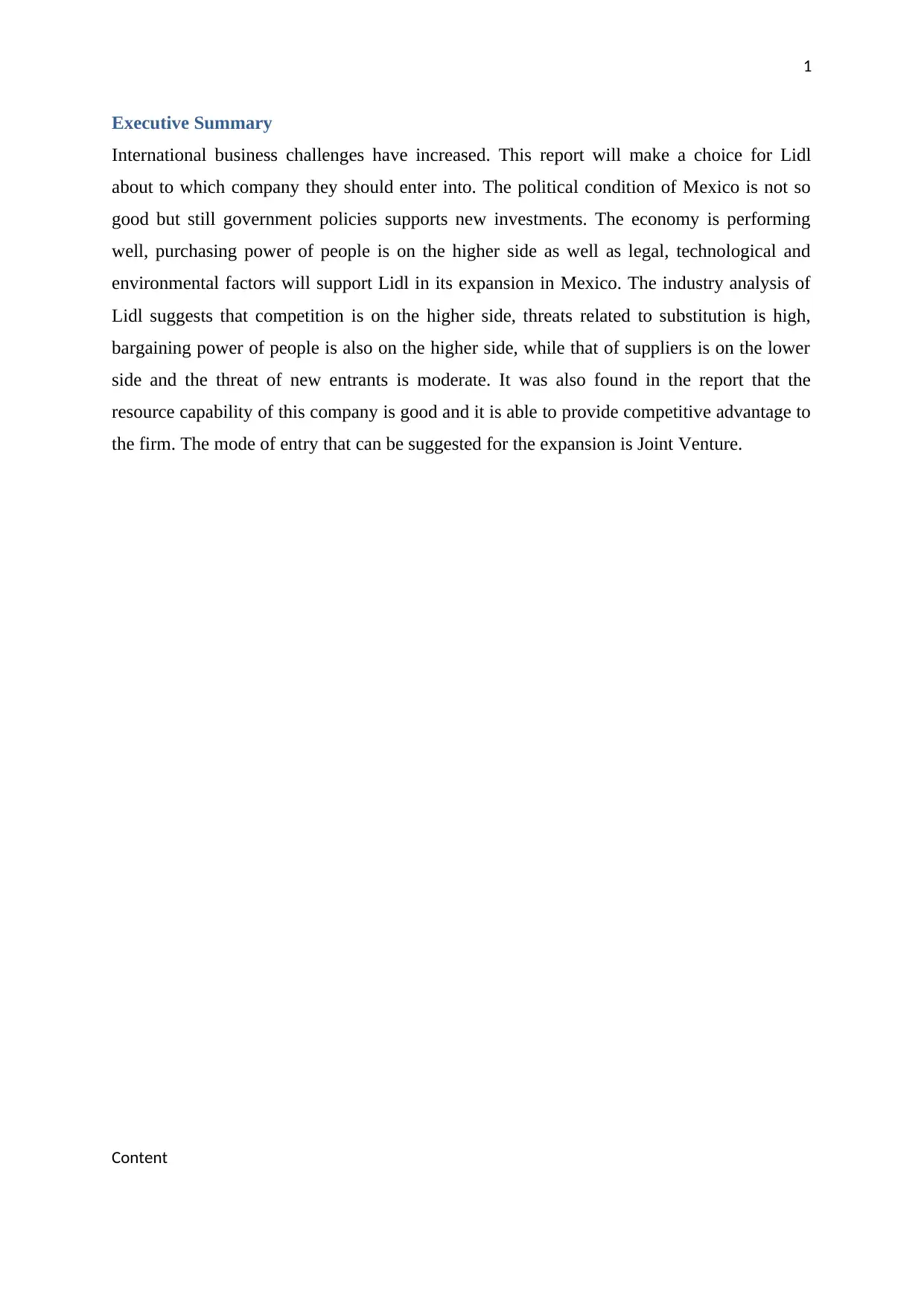
1
Executive Summary
International business challenges have increased. This report will make a choice for Lidl
about to which company they should enter into. The political condition of Mexico is not so
good but still government policies supports new investments. The economy is performing
well, purchasing power of people is on the higher side as well as legal, technological and
environmental factors will support Lidl in its expansion in Mexico. The industry analysis of
Lidl suggests that competition is on the higher side, threats related to substitution is high,
bargaining power of people is also on the higher side, while that of suppliers is on the lower
side and the threat of new entrants is moderate. It was also found in the report that the
resource capability of this company is good and it is able to provide competitive advantage to
the firm. The mode of entry that can be suggested for the expansion is Joint Venture.
Content
Executive Summary
International business challenges have increased. This report will make a choice for Lidl
about to which company they should enter into. The political condition of Mexico is not so
good but still government policies supports new investments. The economy is performing
well, purchasing power of people is on the higher side as well as legal, technological and
environmental factors will support Lidl in its expansion in Mexico. The industry analysis of
Lidl suggests that competition is on the higher side, threats related to substitution is high,
bargaining power of people is also on the higher side, while that of suppliers is on the lower
side and the threat of new entrants is moderate. It was also found in the report that the
resource capability of this company is good and it is able to provide competitive advantage to
the firm. The mode of entry that can be suggested for the expansion is Joint Venture.
Content
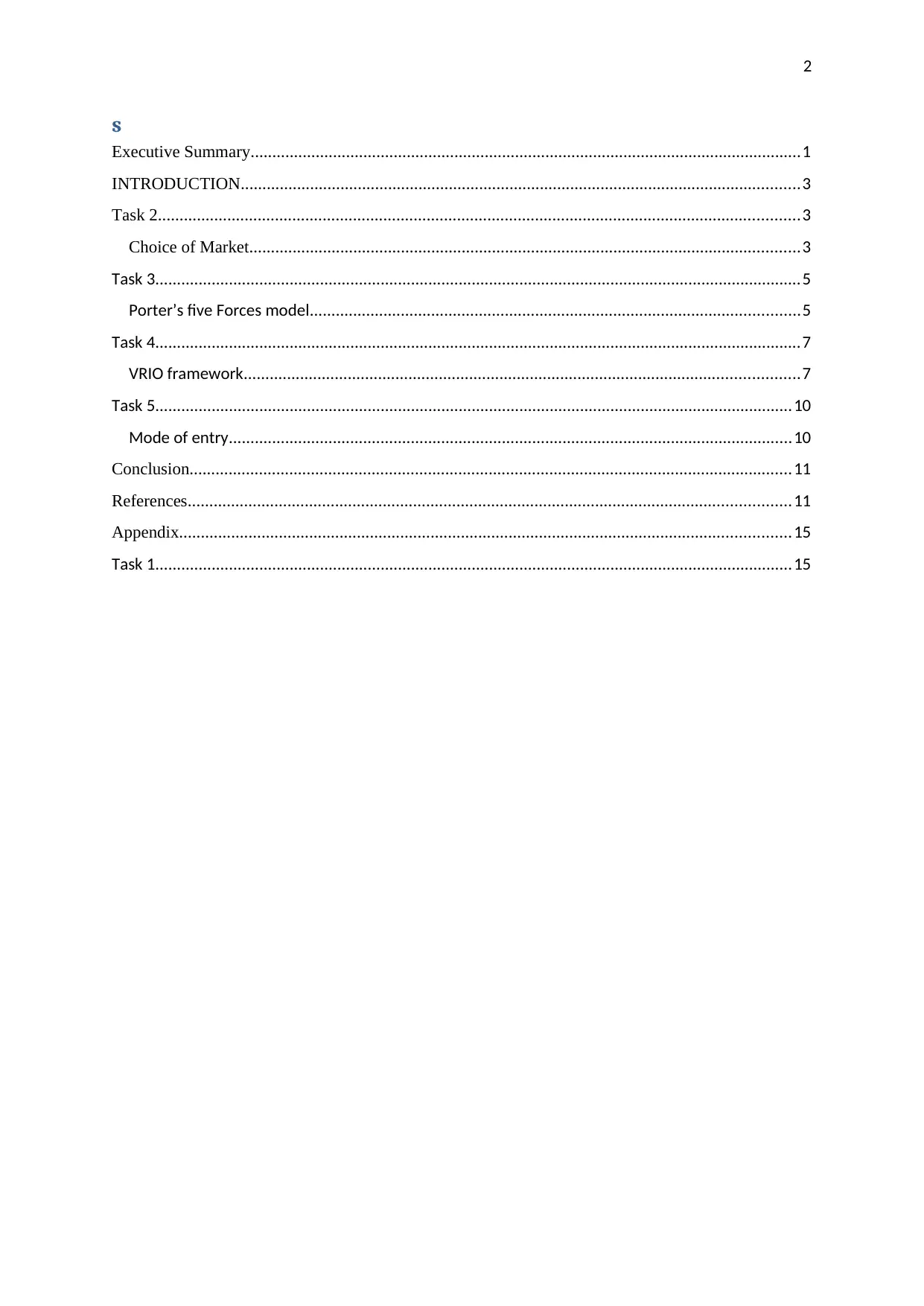
2
s
Executive Summary...............................................................................................................................1
INTRODUCTION.................................................................................................................................3
Task 2....................................................................................................................................................3
Choice of Market...............................................................................................................................3
Task 3.....................................................................................................................................................5
Porter’s five Forces model.................................................................................................................5
Task 4.....................................................................................................................................................7
VRIO framework................................................................................................................................7
Task 5...................................................................................................................................................10
Mode of entry..................................................................................................................................10
Conclusion...........................................................................................................................................11
References...........................................................................................................................................11
Appendix.............................................................................................................................................15
Task 1...................................................................................................................................................15
s
Executive Summary...............................................................................................................................1
INTRODUCTION.................................................................................................................................3
Task 2....................................................................................................................................................3
Choice of Market...............................................................................................................................3
Task 3.....................................................................................................................................................5
Porter’s five Forces model.................................................................................................................5
Task 4.....................................................................................................................................................7
VRIO framework................................................................................................................................7
Task 5...................................................................................................................................................10
Mode of entry..................................................................................................................................10
Conclusion...........................................................................................................................................11
References...........................................................................................................................................11
Appendix.............................................................................................................................................15
Task 1...................................................................................................................................................15
⊘ This is a preview!⊘
Do you want full access?
Subscribe today to unlock all pages.

Trusted by 1+ million students worldwide
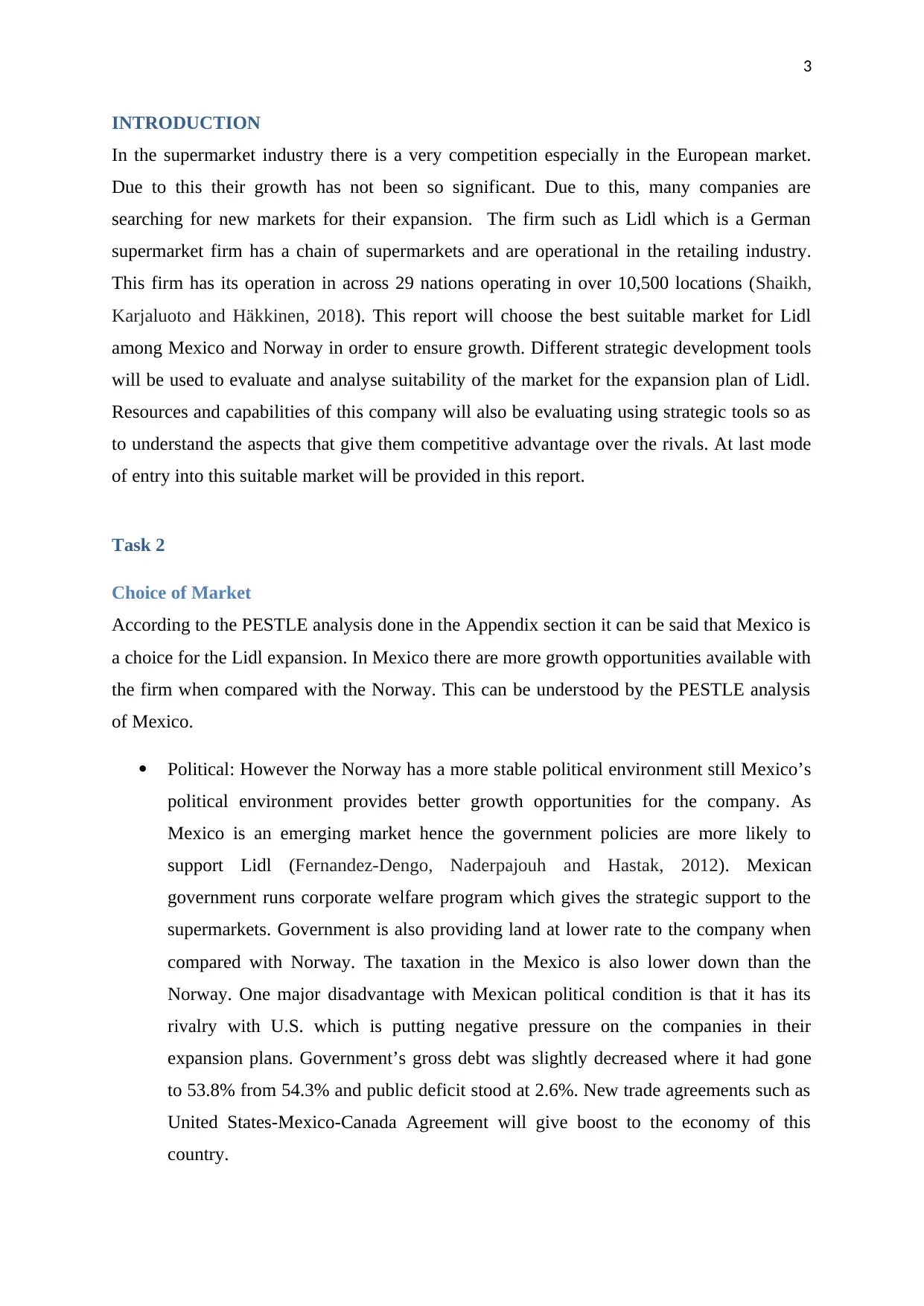
3
INTRODUCTION
In the supermarket industry there is a very competition especially in the European market.
Due to this their growth has not been so significant. Due to this, many companies are
searching for new markets for their expansion. The firm such as Lidl which is a German
supermarket firm has a chain of supermarkets and are operational in the retailing industry.
This firm has its operation in across 29 nations operating in over 10,500 locations (Shaikh,
Karjaluoto and Häkkinen, 2018). This report will choose the best suitable market for Lidl
among Mexico and Norway in order to ensure growth. Different strategic development tools
will be used to evaluate and analyse suitability of the market for the expansion plan of Lidl.
Resources and capabilities of this company will also be evaluating using strategic tools so as
to understand the aspects that give them competitive advantage over the rivals. At last mode
of entry into this suitable market will be provided in this report.
Task 2
Choice of Market
According to the PESTLE analysis done in the Appendix section it can be said that Mexico is
a choice for the Lidl expansion. In Mexico there are more growth opportunities available with
the firm when compared with the Norway. This can be understood by the PESTLE analysis
of Mexico.
Political: However the Norway has a more stable political environment still Mexico’s
political environment provides better growth opportunities for the company. As
Mexico is an emerging market hence the government policies are more likely to
support Lidl (Fernandez-Dengo, Naderpajouh and Hastak, 2012). Mexican
government runs corporate welfare program which gives the strategic support to the
supermarkets. Government is also providing land at lower rate to the company when
compared with Norway. The taxation in the Mexico is also lower down than the
Norway. One major disadvantage with Mexican political condition is that it has its
rivalry with U.S. which is putting negative pressure on the companies in their
expansion plans. Government’s gross debt was slightly decreased where it had gone
to 53.8% from 54.3% and public deficit stood at 2.6%. New trade agreements such as
United States-Mexico-Canada Agreement will give boost to the economy of this
country.
INTRODUCTION
In the supermarket industry there is a very competition especially in the European market.
Due to this their growth has not been so significant. Due to this, many companies are
searching for new markets for their expansion. The firm such as Lidl which is a German
supermarket firm has a chain of supermarkets and are operational in the retailing industry.
This firm has its operation in across 29 nations operating in over 10,500 locations (Shaikh,
Karjaluoto and Häkkinen, 2018). This report will choose the best suitable market for Lidl
among Mexico and Norway in order to ensure growth. Different strategic development tools
will be used to evaluate and analyse suitability of the market for the expansion plan of Lidl.
Resources and capabilities of this company will also be evaluating using strategic tools so as
to understand the aspects that give them competitive advantage over the rivals. At last mode
of entry into this suitable market will be provided in this report.
Task 2
Choice of Market
According to the PESTLE analysis done in the Appendix section it can be said that Mexico is
a choice for the Lidl expansion. In Mexico there are more growth opportunities available with
the firm when compared with the Norway. This can be understood by the PESTLE analysis
of Mexico.
Political: However the Norway has a more stable political environment still Mexico’s
political environment provides better growth opportunities for the company. As
Mexico is an emerging market hence the government policies are more likely to
support Lidl (Fernandez-Dengo, Naderpajouh and Hastak, 2012). Mexican
government runs corporate welfare program which gives the strategic support to the
supermarkets. Government is also providing land at lower rate to the company when
compared with Norway. The taxation in the Mexico is also lower down than the
Norway. One major disadvantage with Mexican political condition is that it has its
rivalry with U.S. which is putting negative pressure on the companies in their
expansion plans. Government’s gross debt was slightly decreased where it had gone
to 53.8% from 54.3% and public deficit stood at 2.6%. New trade agreements such as
United States-Mexico-Canada Agreement will give boost to the economy of this
country.
Paraphrase This Document
Need a fresh take? Get an instant paraphrase of this document with our AI Paraphraser
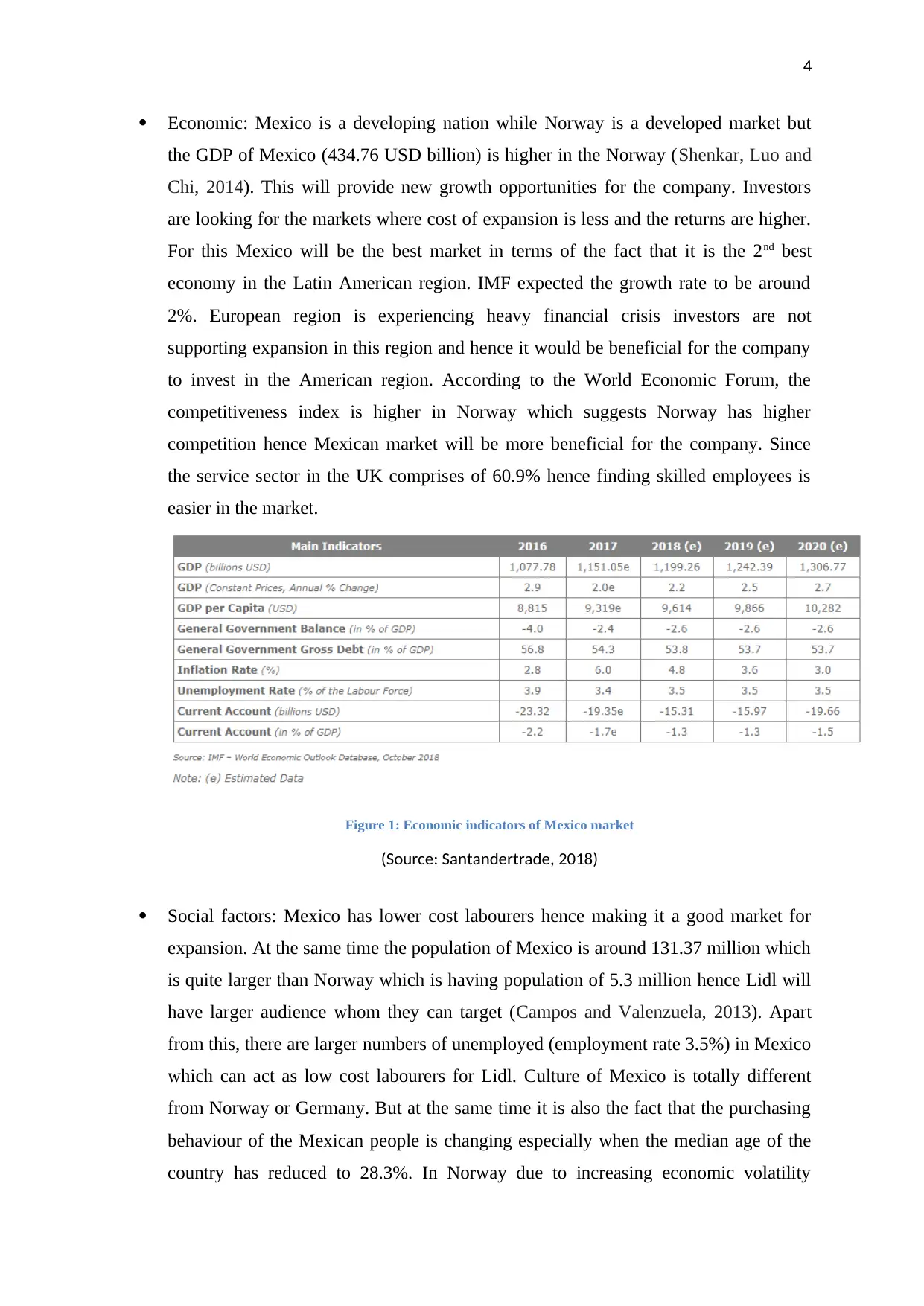
4
Economic: Mexico is a developing nation while Norway is a developed market but
the GDP of Mexico (434.76 USD billion) is higher in the Norway (Shenkar, Luo and
Chi, 2014). This will provide new growth opportunities for the company. Investors
are looking for the markets where cost of expansion is less and the returns are higher.
For this Mexico will be the best market in terms of the fact that it is the 2nd best
economy in the Latin American region. IMF expected the growth rate to be around
2%. European region is experiencing heavy financial crisis investors are not
supporting expansion in this region and hence it would be beneficial for the company
to invest in the American region. According to the World Economic Forum, the
competitiveness index is higher in Norway which suggests Norway has higher
competition hence Mexican market will be more beneficial for the company. Since
the service sector in the UK comprises of 60.9% hence finding skilled employees is
easier in the market.
Figure 1: Economic indicators of Mexico market
(Source: Santandertrade, 2018)
Social factors: Mexico has lower cost labourers hence making it a good market for
expansion. At the same time the population of Mexico is around 131.37 million which
is quite larger than Norway which is having population of 5.3 million hence Lidl will
have larger audience whom they can target (Campos and Valenzuela, 2013). Apart
from this, there are larger numbers of unemployed (employment rate 3.5%) in Mexico
which can act as low cost labourers for Lidl. Culture of Mexico is totally different
from Norway or Germany. But at the same time it is also the fact that the purchasing
behaviour of the Mexican people is changing especially when the median age of the
country has reduced to 28.3%. In Norway due to increasing economic volatility
Economic: Mexico is a developing nation while Norway is a developed market but
the GDP of Mexico (434.76 USD billion) is higher in the Norway (Shenkar, Luo and
Chi, 2014). This will provide new growth opportunities for the company. Investors
are looking for the markets where cost of expansion is less and the returns are higher.
For this Mexico will be the best market in terms of the fact that it is the 2nd best
economy in the Latin American region. IMF expected the growth rate to be around
2%. European region is experiencing heavy financial crisis investors are not
supporting expansion in this region and hence it would be beneficial for the company
to invest in the American region. According to the World Economic Forum, the
competitiveness index is higher in Norway which suggests Norway has higher
competition hence Mexican market will be more beneficial for the company. Since
the service sector in the UK comprises of 60.9% hence finding skilled employees is
easier in the market.
Figure 1: Economic indicators of Mexico market
(Source: Santandertrade, 2018)
Social factors: Mexico has lower cost labourers hence making it a good market for
expansion. At the same time the population of Mexico is around 131.37 million which
is quite larger than Norway which is having population of 5.3 million hence Lidl will
have larger audience whom they can target (Campos and Valenzuela, 2013). Apart
from this, there are larger numbers of unemployed (employment rate 3.5%) in Mexico
which can act as low cost labourers for Lidl. Culture of Mexico is totally different
from Norway or Germany. But at the same time it is also the fact that the purchasing
behaviour of the Mexican people is changing especially when the median age of the
country has reduced to 28.3%. In Norway due to increasing economic volatility
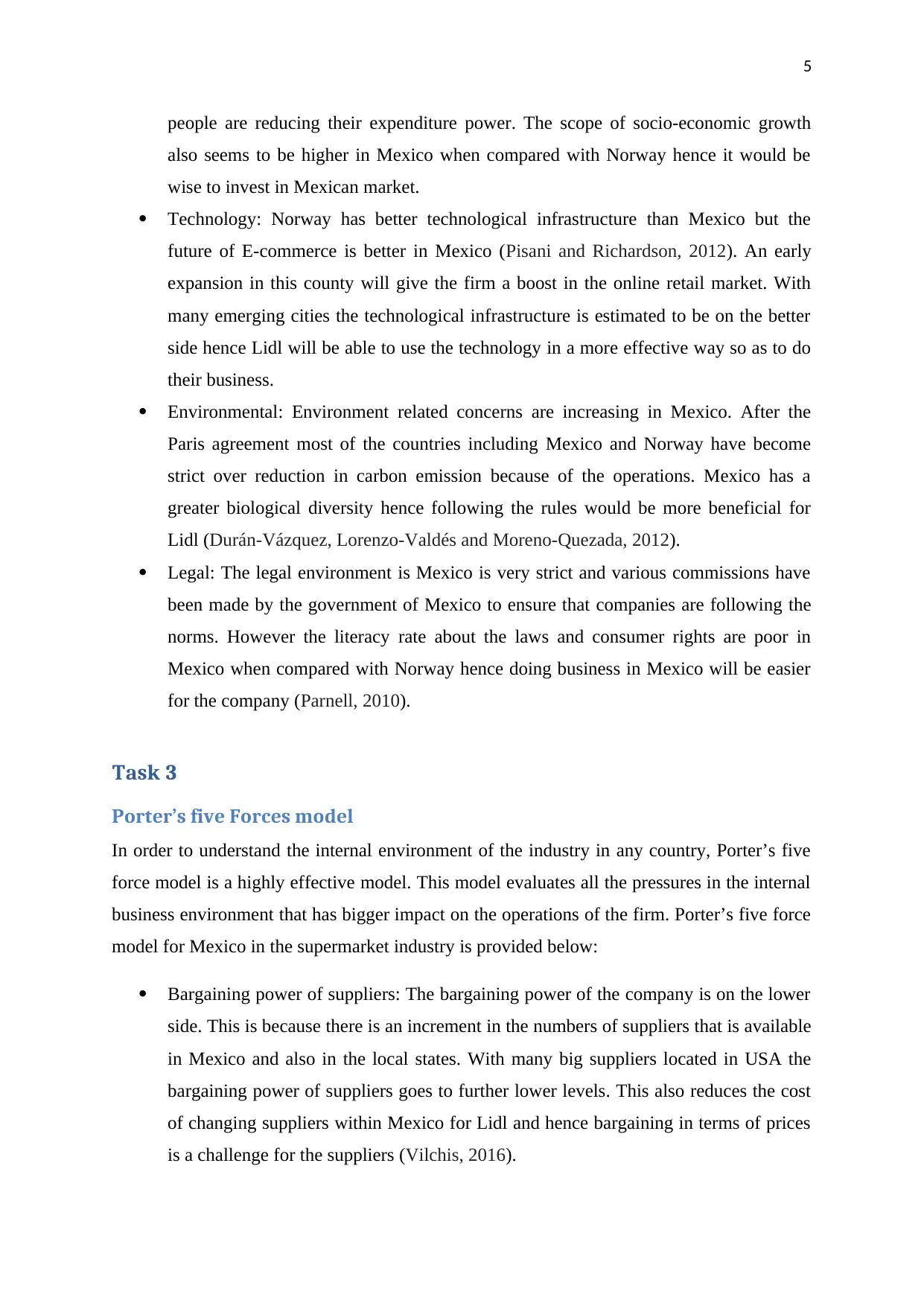
5
people are reducing their expenditure power. The scope of socio-economic growth
also seems to be higher in Mexico when compared with Norway hence it would be
wise to invest in Mexican market.
Technology: Norway has better technological infrastructure than Mexico but the
future of E-commerce is better in Mexico (Pisani and Richardson, 2012). An early
expansion in this county will give the firm a boost in the online retail market. With
many emerging cities the technological infrastructure is estimated to be on the better
side hence Lidl will be able to use the technology in a more effective way so as to do
their business.
Environmental: Environment related concerns are increasing in Mexico. After the
Paris agreement most of the countries including Mexico and Norway have become
strict over reduction in carbon emission because of the operations. Mexico has a
greater biological diversity hence following the rules would be more beneficial for
Lidl (Durán-Vázquez, Lorenzo-Valdés and Moreno-Quezada, 2012).
Legal: The legal environment is Mexico is very strict and various commissions have
been made by the government of Mexico to ensure that companies are following the
norms. However the literacy rate about the laws and consumer rights are poor in
Mexico when compared with Norway hence doing business in Mexico will be easier
for the company (Parnell, 2010).
Task 3
Porter’s five Forces model
In order to understand the internal environment of the industry in any country, Porter’s five
force model is a highly effective model. This model evaluates all the pressures in the internal
business environment that has bigger impact on the operations of the firm. Porter’s five force
model for Mexico in the supermarket industry is provided below:
Bargaining power of suppliers: The bargaining power of the company is on the lower
side. This is because there is an increment in the numbers of suppliers that is available
in Mexico and also in the local states. With many big suppliers located in USA the
bargaining power of suppliers goes to further lower levels. This also reduces the cost
of changing suppliers within Mexico for Lidl and hence bargaining in terms of prices
is a challenge for the suppliers (Vilchis, 2016).
people are reducing their expenditure power. The scope of socio-economic growth
also seems to be higher in Mexico when compared with Norway hence it would be
wise to invest in Mexican market.
Technology: Norway has better technological infrastructure than Mexico but the
future of E-commerce is better in Mexico (Pisani and Richardson, 2012). An early
expansion in this county will give the firm a boost in the online retail market. With
many emerging cities the technological infrastructure is estimated to be on the better
side hence Lidl will be able to use the technology in a more effective way so as to do
their business.
Environmental: Environment related concerns are increasing in Mexico. After the
Paris agreement most of the countries including Mexico and Norway have become
strict over reduction in carbon emission because of the operations. Mexico has a
greater biological diversity hence following the rules would be more beneficial for
Lidl (Durán-Vázquez, Lorenzo-Valdés and Moreno-Quezada, 2012).
Legal: The legal environment is Mexico is very strict and various commissions have
been made by the government of Mexico to ensure that companies are following the
norms. However the literacy rate about the laws and consumer rights are poor in
Mexico when compared with Norway hence doing business in Mexico will be easier
for the company (Parnell, 2010).
Task 3
Porter’s five Forces model
In order to understand the internal environment of the industry in any country, Porter’s five
force model is a highly effective model. This model evaluates all the pressures in the internal
business environment that has bigger impact on the operations of the firm. Porter’s five force
model for Mexico in the supermarket industry is provided below:
Bargaining power of suppliers: The bargaining power of the company is on the lower
side. This is because there is an increment in the numbers of suppliers that is available
in Mexico and also in the local states. With many big suppliers located in USA the
bargaining power of suppliers goes to further lower levels. This also reduces the cost
of changing suppliers within Mexico for Lidl and hence bargaining in terms of prices
is a challenge for the suppliers (Vilchis, 2016).
⊘ This is a preview!⊘
Do you want full access?
Subscribe today to unlock all pages.

Trusted by 1+ million students worldwide
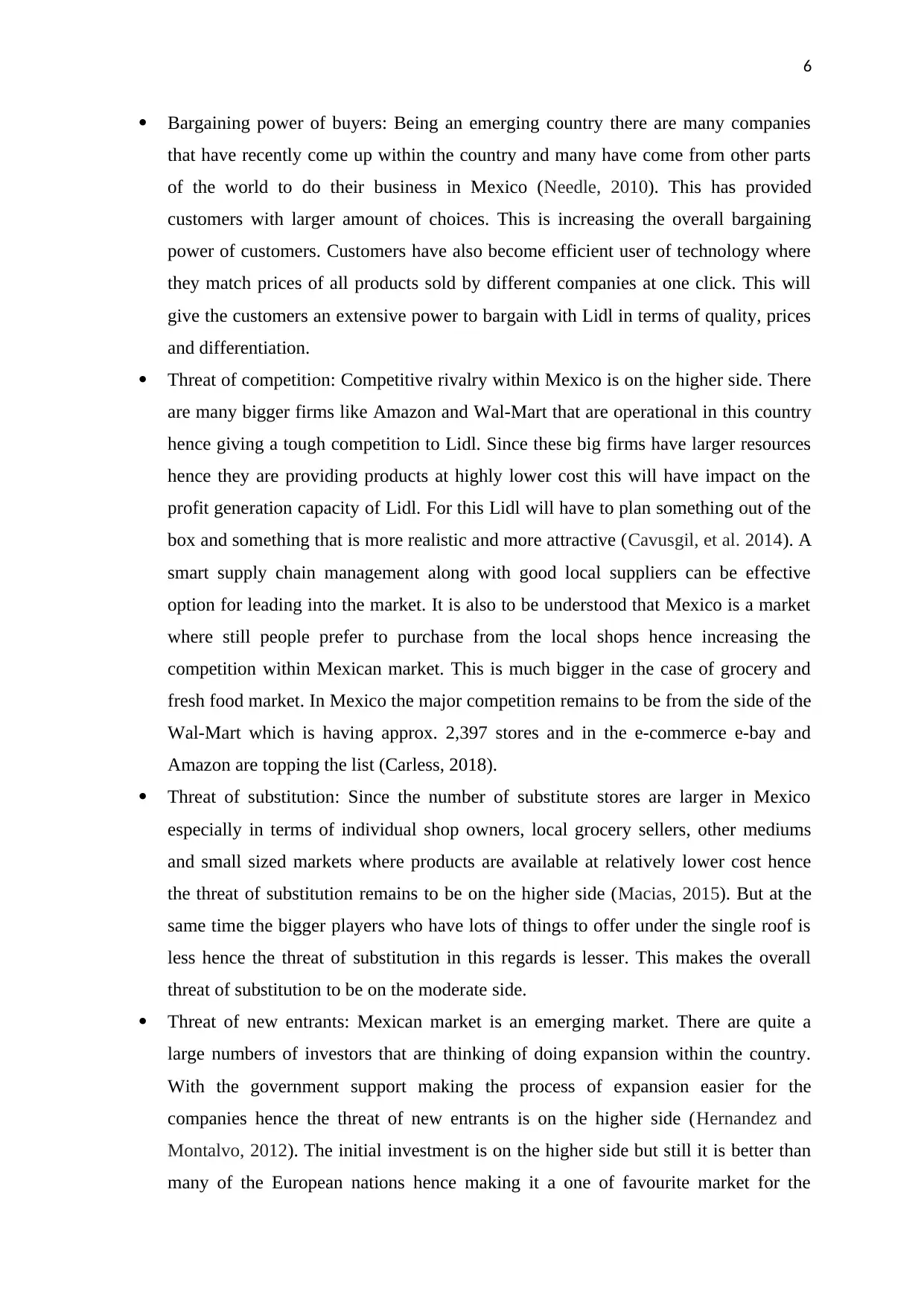
6
Bargaining power of buyers: Being an emerging country there are many companies
that have recently come up within the country and many have come from other parts
of the world to do their business in Mexico (Needle, 2010). This has provided
customers with larger amount of choices. This is increasing the overall bargaining
power of customers. Customers have also become efficient user of technology where
they match prices of all products sold by different companies at one click. This will
give the customers an extensive power to bargain with Lidl in terms of quality, prices
and differentiation.
Threat of competition: Competitive rivalry within Mexico is on the higher side. There
are many bigger firms like Amazon and Wal-Mart that are operational in this country
hence giving a tough competition to Lidl. Since these big firms have larger resources
hence they are providing products at highly lower cost this will have impact on the
profit generation capacity of Lidl. For this Lidl will have to plan something out of the
box and something that is more realistic and more attractive (Cavusgil, et al. 2014). A
smart supply chain management along with good local suppliers can be effective
option for leading into the market. It is also to be understood that Mexico is a market
where still people prefer to purchase from the local shops hence increasing the
competition within Mexican market. This is much bigger in the case of grocery and
fresh food market. In Mexico the major competition remains to be from the side of the
Wal-Mart which is having approx. 2,397 stores and in the e-commerce e-bay and
Amazon are topping the list (Carless, 2018).
Threat of substitution: Since the number of substitute stores are larger in Mexico
especially in terms of individual shop owners, local grocery sellers, other mediums
and small sized markets where products are available at relatively lower cost hence
the threat of substitution remains to be on the higher side (Macias, 2015). But at the
same time the bigger players who have lots of things to offer under the single roof is
less hence the threat of substitution in this regards is lesser. This makes the overall
threat of substitution to be on the moderate side.
Threat of new entrants: Mexican market is an emerging market. There are quite a
large numbers of investors that are thinking of doing expansion within the country.
With the government support making the process of expansion easier for the
companies hence the threat of new entrants is on the higher side (Hernandez and
Montalvo, 2012). The initial investment is on the higher side but still it is better than
many of the European nations hence making it a one of favourite market for the
Bargaining power of buyers: Being an emerging country there are many companies
that have recently come up within the country and many have come from other parts
of the world to do their business in Mexico (Needle, 2010). This has provided
customers with larger amount of choices. This is increasing the overall bargaining
power of customers. Customers have also become efficient user of technology where
they match prices of all products sold by different companies at one click. This will
give the customers an extensive power to bargain with Lidl in terms of quality, prices
and differentiation.
Threat of competition: Competitive rivalry within Mexico is on the higher side. There
are many bigger firms like Amazon and Wal-Mart that are operational in this country
hence giving a tough competition to Lidl. Since these big firms have larger resources
hence they are providing products at highly lower cost this will have impact on the
profit generation capacity of Lidl. For this Lidl will have to plan something out of the
box and something that is more realistic and more attractive (Cavusgil, et al. 2014). A
smart supply chain management along with good local suppliers can be effective
option for leading into the market. It is also to be understood that Mexico is a market
where still people prefer to purchase from the local shops hence increasing the
competition within Mexican market. This is much bigger in the case of grocery and
fresh food market. In Mexico the major competition remains to be from the side of the
Wal-Mart which is having approx. 2,397 stores and in the e-commerce e-bay and
Amazon are topping the list (Carless, 2018).
Threat of substitution: Since the number of substitute stores are larger in Mexico
especially in terms of individual shop owners, local grocery sellers, other mediums
and small sized markets where products are available at relatively lower cost hence
the threat of substitution remains to be on the higher side (Macias, 2015). But at the
same time the bigger players who have lots of things to offer under the single roof is
less hence the threat of substitution in this regards is lesser. This makes the overall
threat of substitution to be on the moderate side.
Threat of new entrants: Mexican market is an emerging market. There are quite a
large numbers of investors that are thinking of doing expansion within the country.
With the government support making the process of expansion easier for the
companies hence the threat of new entrants is on the higher side (Hernandez and
Montalvo, 2012). The initial investment is on the higher side but still it is better than
many of the European nations hence making it a one of favourite market for the
Paraphrase This Document
Need a fresh take? Get an instant paraphrase of this document with our AI Paraphraser
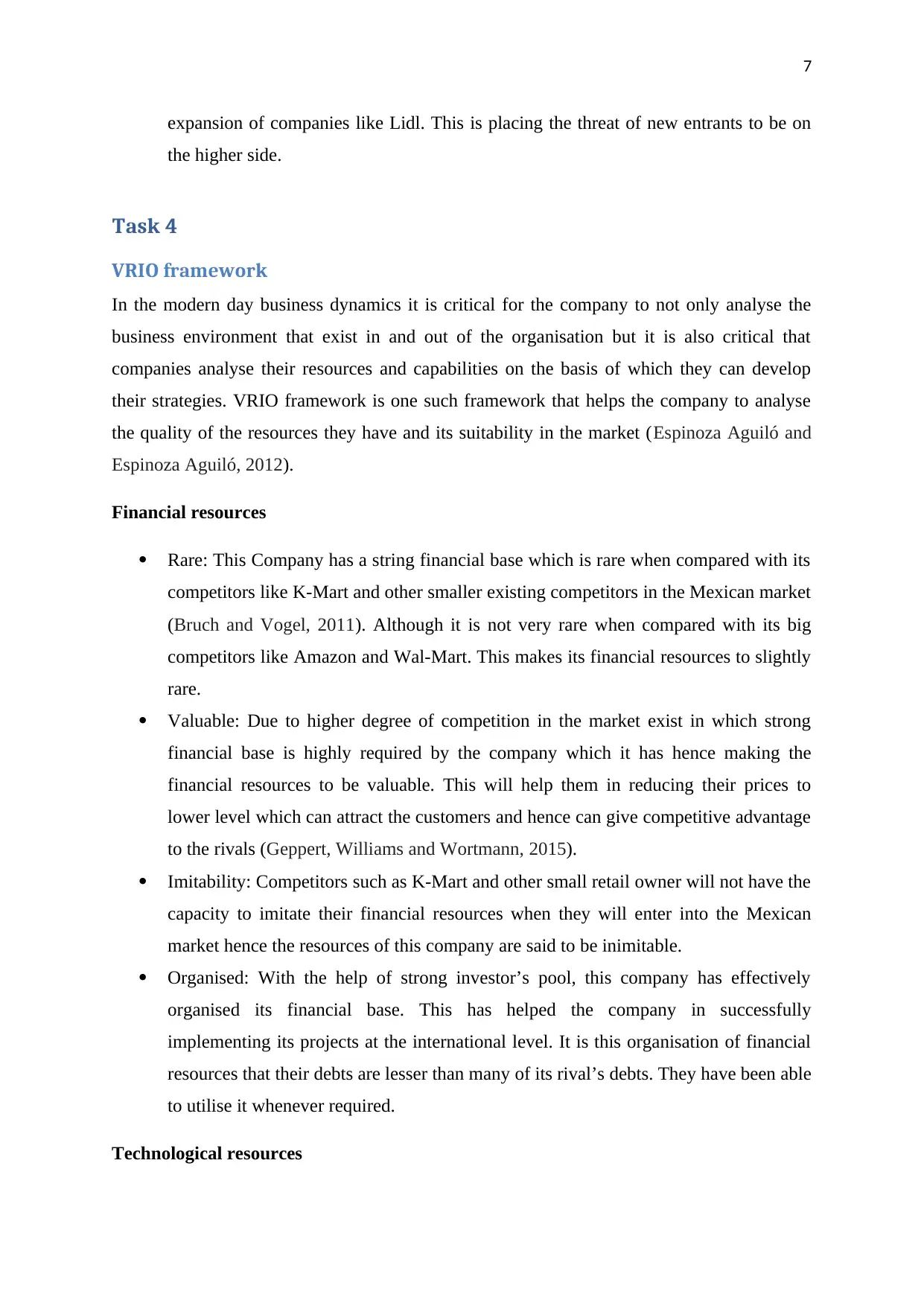
7
expansion of companies like Lidl. This is placing the threat of new entrants to be on
the higher side.
Task 4
VRIO framework
In the modern day business dynamics it is critical for the company to not only analyse the
business environment that exist in and out of the organisation but it is also critical that
companies analyse their resources and capabilities on the basis of which they can develop
their strategies. VRIO framework is one such framework that helps the company to analyse
the quality of the resources they have and its suitability in the market (Espinoza Aguiló and
Espinoza Aguiló, 2012).
Financial resources
Rare: This Company has a string financial base which is rare when compared with its
competitors like K-Mart and other smaller existing competitors in the Mexican market
(Bruch and Vogel, 2011). Although it is not very rare when compared with its big
competitors like Amazon and Wal-Mart. This makes its financial resources to slightly
rare.
Valuable: Due to higher degree of competition in the market exist in which strong
financial base is highly required by the company which it has hence making the
financial resources to be valuable. This will help them in reducing their prices to
lower level which can attract the customers and hence can give competitive advantage
to the rivals (Geppert, Williams and Wortmann, 2015).
Imitability: Competitors such as K-Mart and other small retail owner will not have the
capacity to imitate their financial resources when they will enter into the Mexican
market hence the resources of this company are said to be inimitable.
Organised: With the help of strong investor’s pool, this company has effectively
organised its financial base. This has helped the company in successfully
implementing its projects at the international level. It is this organisation of financial
resources that their debts are lesser than many of its rival’s debts. They have been able
to utilise it whenever required.
Technological resources
expansion of companies like Lidl. This is placing the threat of new entrants to be on
the higher side.
Task 4
VRIO framework
In the modern day business dynamics it is critical for the company to not only analyse the
business environment that exist in and out of the organisation but it is also critical that
companies analyse their resources and capabilities on the basis of which they can develop
their strategies. VRIO framework is one such framework that helps the company to analyse
the quality of the resources they have and its suitability in the market (Espinoza Aguiló and
Espinoza Aguiló, 2012).
Financial resources
Rare: This Company has a string financial base which is rare when compared with its
competitors like K-Mart and other smaller existing competitors in the Mexican market
(Bruch and Vogel, 2011). Although it is not very rare when compared with its big
competitors like Amazon and Wal-Mart. This makes its financial resources to slightly
rare.
Valuable: Due to higher degree of competition in the market exist in which strong
financial base is highly required by the company which it has hence making the
financial resources to be valuable. This will help them in reducing their prices to
lower level which can attract the customers and hence can give competitive advantage
to the rivals (Geppert, Williams and Wortmann, 2015).
Imitability: Competitors such as K-Mart and other small retail owner will not have the
capacity to imitate their financial resources when they will enter into the Mexican
market hence the resources of this company are said to be inimitable.
Organised: With the help of strong investor’s pool, this company has effectively
organised its financial base. This has helped the company in successfully
implementing its projects at the international level. It is this organisation of financial
resources that their debts are lesser than many of its rival’s debts. They have been able
to utilise it whenever required.
Technological resources
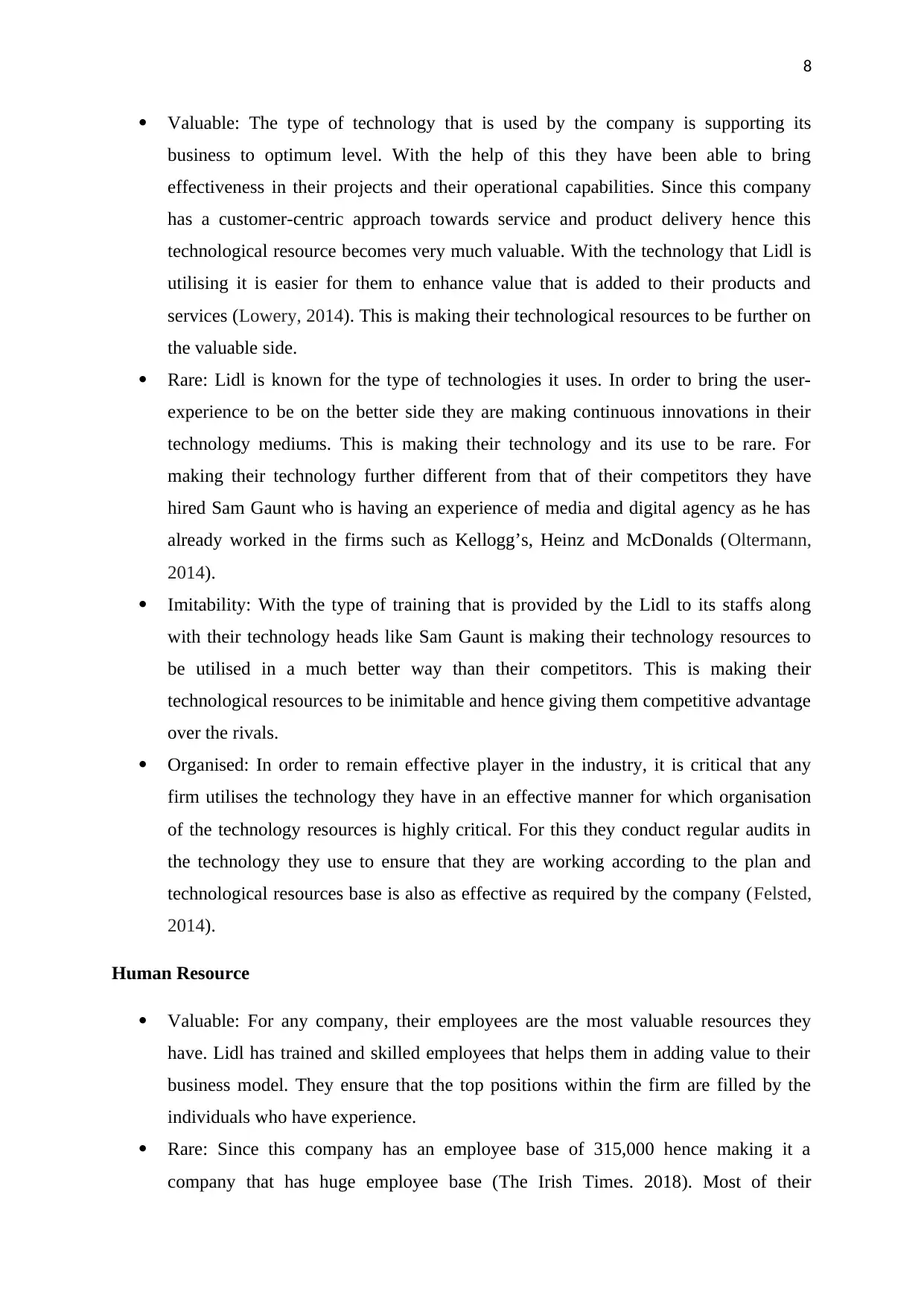
8
Valuable: The type of technology that is used by the company is supporting its
business to optimum level. With the help of this they have been able to bring
effectiveness in their projects and their operational capabilities. Since this company
has a customer-centric approach towards service and product delivery hence this
technological resource becomes very much valuable. With the technology that Lidl is
utilising it is easier for them to enhance value that is added to their products and
services (Lowery, 2014). This is making their technological resources to be further on
the valuable side.
Rare: Lidl is known for the type of technologies it uses. In order to bring the user-
experience to be on the better side they are making continuous innovations in their
technology mediums. This is making their technology and its use to be rare. For
making their technology further different from that of their competitors they have
hired Sam Gaunt who is having an experience of media and digital agency as he has
already worked in the firms such as Kellogg’s, Heinz and McDonalds (Oltermann,
2014).
Imitability: With the type of training that is provided by the Lidl to its staffs along
with their technology heads like Sam Gaunt is making their technology resources to
be utilised in a much better way than their competitors. This is making their
technological resources to be inimitable and hence giving them competitive advantage
over the rivals.
Organised: In order to remain effective player in the industry, it is critical that any
firm utilises the technology they have in an effective manner for which organisation
of the technology resources is highly critical. For this they conduct regular audits in
the technology they use to ensure that they are working according to the plan and
technological resources base is also as effective as required by the company (Felsted,
2014).
Human Resource
Valuable: For any company, their employees are the most valuable resources they
have. Lidl has trained and skilled employees that helps them in adding value to their
business model. They ensure that the top positions within the firm are filled by the
individuals who have experience.
Rare: Since this company has an employee base of 315,000 hence making it a
company that has huge employee base (The Irish Times. 2018). Most of their
Valuable: The type of technology that is used by the company is supporting its
business to optimum level. With the help of this they have been able to bring
effectiveness in their projects and their operational capabilities. Since this company
has a customer-centric approach towards service and product delivery hence this
technological resource becomes very much valuable. With the technology that Lidl is
utilising it is easier for them to enhance value that is added to their products and
services (Lowery, 2014). This is making their technological resources to be further on
the valuable side.
Rare: Lidl is known for the type of technologies it uses. In order to bring the user-
experience to be on the better side they are making continuous innovations in their
technology mediums. This is making their technology and its use to be rare. For
making their technology further different from that of their competitors they have
hired Sam Gaunt who is having an experience of media and digital agency as he has
already worked in the firms such as Kellogg’s, Heinz and McDonalds (Oltermann,
2014).
Imitability: With the type of training that is provided by the Lidl to its staffs along
with their technology heads like Sam Gaunt is making their technology resources to
be utilised in a much better way than their competitors. This is making their
technological resources to be inimitable and hence giving them competitive advantage
over the rivals.
Organised: In order to remain effective player in the industry, it is critical that any
firm utilises the technology they have in an effective manner for which organisation
of the technology resources is highly critical. For this they conduct regular audits in
the technology they use to ensure that they are working according to the plan and
technological resources base is also as effective as required by the company (Felsted,
2014).
Human Resource
Valuable: For any company, their employees are the most valuable resources they
have. Lidl has trained and skilled employees that helps them in adding value to their
business model. They ensure that the top positions within the firm are filled by the
individuals who have experience.
Rare: Since this company has an employee base of 315,000 hence making it a
company that has huge employee base (The Irish Times. 2018). Most of their
⊘ This is a preview!⊘
Do you want full access?
Subscribe today to unlock all pages.

Trusted by 1+ million students worldwide
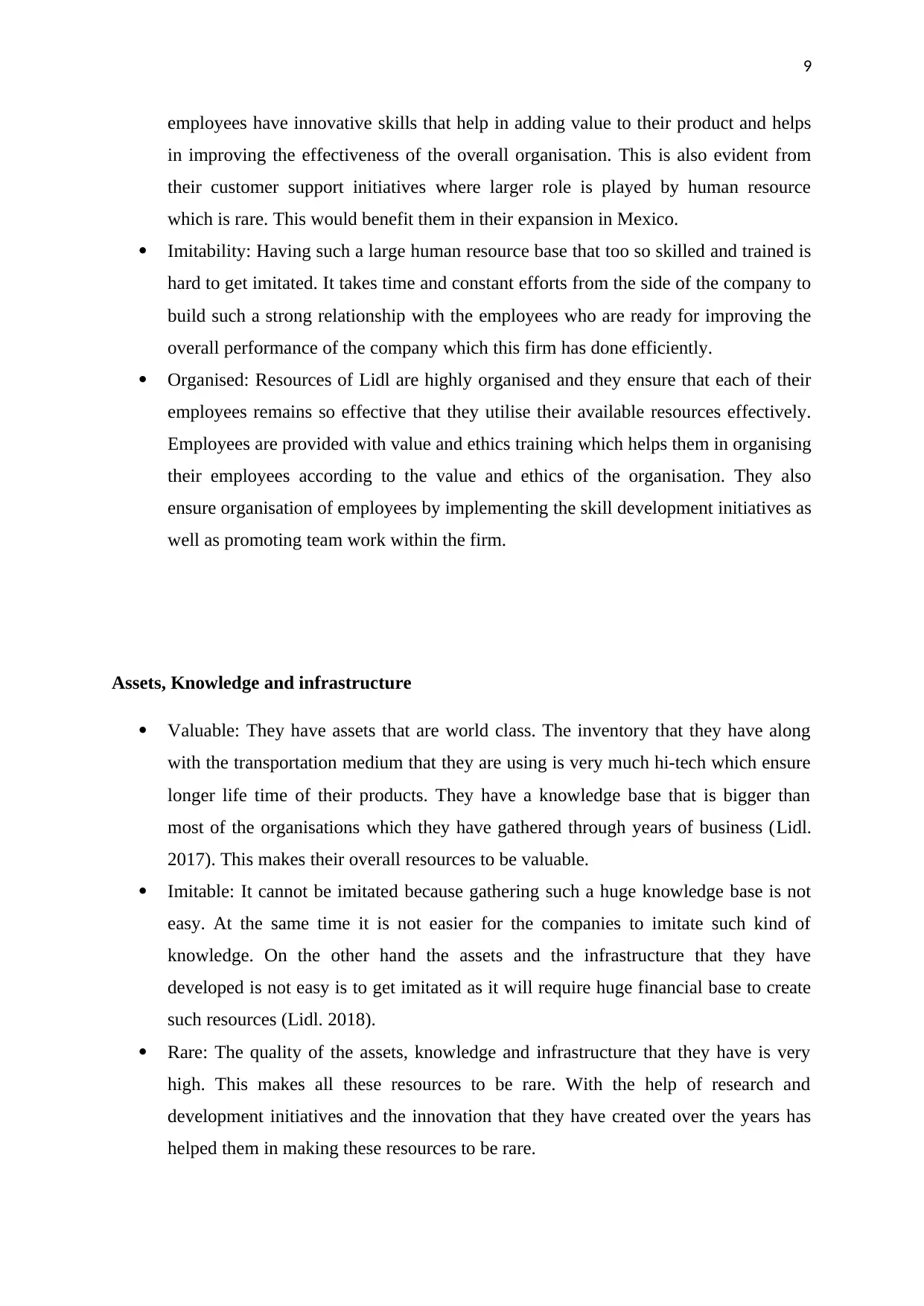
9
employees have innovative skills that help in adding value to their product and helps
in improving the effectiveness of the overall organisation. This is also evident from
their customer support initiatives where larger role is played by human resource
which is rare. This would benefit them in their expansion in Mexico.
Imitability: Having such a large human resource base that too so skilled and trained is
hard to get imitated. It takes time and constant efforts from the side of the company to
build such a strong relationship with the employees who are ready for improving the
overall performance of the company which this firm has done efficiently.
Organised: Resources of Lidl are highly organised and they ensure that each of their
employees remains so effective that they utilise their available resources effectively.
Employees are provided with value and ethics training which helps them in organising
their employees according to the value and ethics of the organisation. They also
ensure organisation of employees by implementing the skill development initiatives as
well as promoting team work within the firm.
Assets, Knowledge and infrastructure
Valuable: They have assets that are world class. The inventory that they have along
with the transportation medium that they are using is very much hi-tech which ensure
longer life time of their products. They have a knowledge base that is bigger than
most of the organisations which they have gathered through years of business (Lidl.
2017). This makes their overall resources to be valuable.
Imitable: It cannot be imitated because gathering such a huge knowledge base is not
easy. At the same time it is not easier for the companies to imitate such kind of
knowledge. On the other hand the assets and the infrastructure that they have
developed is not easy is to get imitated as it will require huge financial base to create
such resources (Lidl. 2018).
Rare: The quality of the assets, knowledge and infrastructure that they have is very
high. This makes all these resources to be rare. With the help of research and
development initiatives and the innovation that they have created over the years has
helped them in making these resources to be rare.
employees have innovative skills that help in adding value to their product and helps
in improving the effectiveness of the overall organisation. This is also evident from
their customer support initiatives where larger role is played by human resource
which is rare. This would benefit them in their expansion in Mexico.
Imitability: Having such a large human resource base that too so skilled and trained is
hard to get imitated. It takes time and constant efforts from the side of the company to
build such a strong relationship with the employees who are ready for improving the
overall performance of the company which this firm has done efficiently.
Organised: Resources of Lidl are highly organised and they ensure that each of their
employees remains so effective that they utilise their available resources effectively.
Employees are provided with value and ethics training which helps them in organising
their employees according to the value and ethics of the organisation. They also
ensure organisation of employees by implementing the skill development initiatives as
well as promoting team work within the firm.
Assets, Knowledge and infrastructure
Valuable: They have assets that are world class. The inventory that they have along
with the transportation medium that they are using is very much hi-tech which ensure
longer life time of their products. They have a knowledge base that is bigger than
most of the organisations which they have gathered through years of business (Lidl.
2017). This makes their overall resources to be valuable.
Imitable: It cannot be imitated because gathering such a huge knowledge base is not
easy. At the same time it is not easier for the companies to imitate such kind of
knowledge. On the other hand the assets and the infrastructure that they have
developed is not easy is to get imitated as it will require huge financial base to create
such resources (Lidl. 2018).
Rare: The quality of the assets, knowledge and infrastructure that they have is very
high. This makes all these resources to be rare. With the help of research and
development initiatives and the innovation that they have created over the years has
helped them in making these resources to be rare.
Paraphrase This Document
Need a fresh take? Get an instant paraphrase of this document with our AI Paraphraser
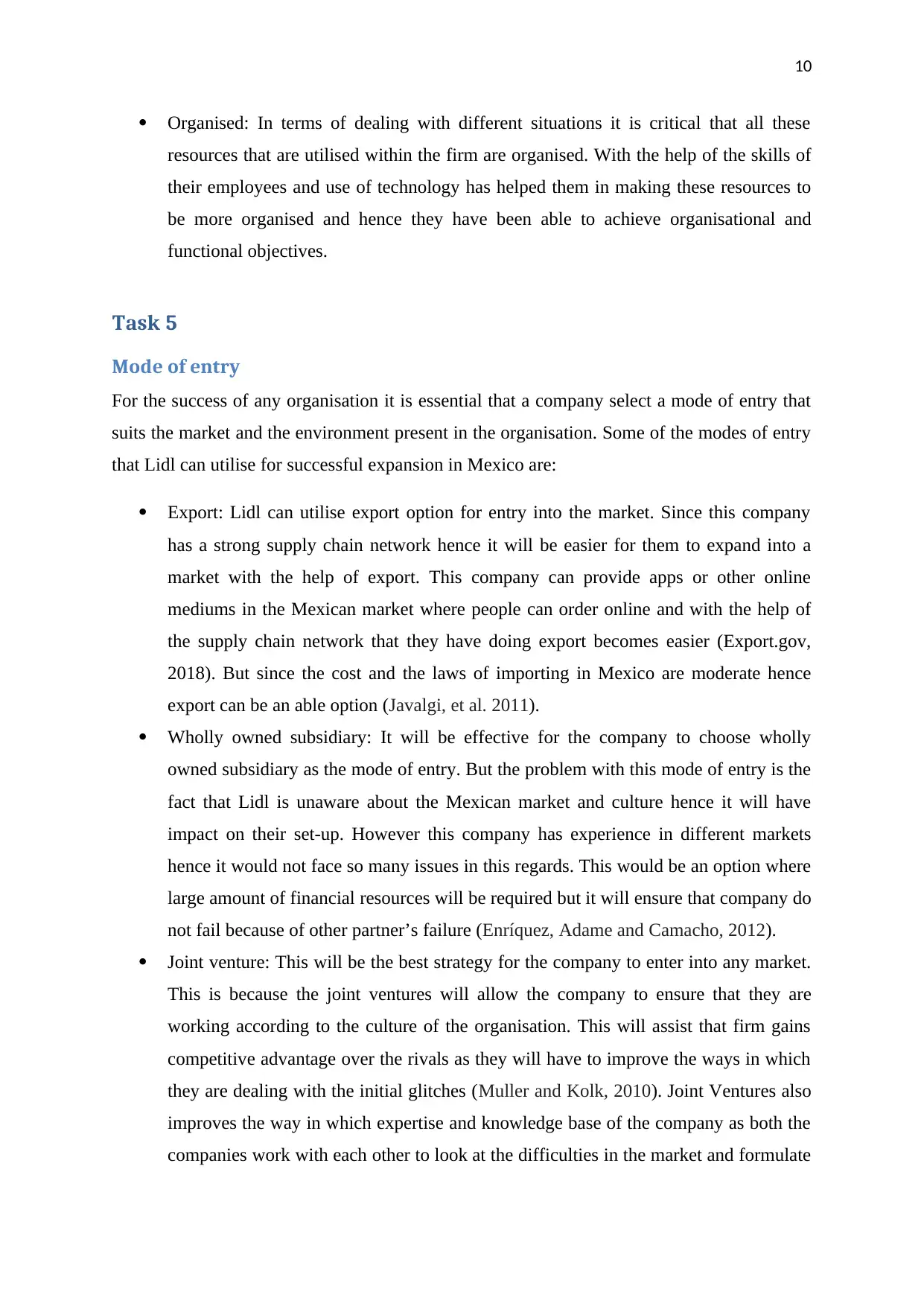
10
Organised: In terms of dealing with different situations it is critical that all these
resources that are utilised within the firm are organised. With the help of the skills of
their employees and use of technology has helped them in making these resources to
be more organised and hence they have been able to achieve organisational and
functional objectives.
Task 5
Mode of entry
For the success of any organisation it is essential that a company select a mode of entry that
suits the market and the environment present in the organisation. Some of the modes of entry
that Lidl can utilise for successful expansion in Mexico are:
Export: Lidl can utilise export option for entry into the market. Since this company
has a strong supply chain network hence it will be easier for them to expand into a
market with the help of export. This company can provide apps or other online
mediums in the Mexican market where people can order online and with the help of
the supply chain network that they have doing export becomes easier (Export.gov,
2018). But since the cost and the laws of importing in Mexico are moderate hence
export can be an able option (Javalgi, et al. 2011).
Wholly owned subsidiary: It will be effective for the company to choose wholly
owned subsidiary as the mode of entry. But the problem with this mode of entry is the
fact that Lidl is unaware about the Mexican market and culture hence it will have
impact on their set-up. However this company has experience in different markets
hence it would not face so many issues in this regards. This would be an option where
large amount of financial resources will be required but it will ensure that company do
not fail because of other partner’s failure (Enríquez, Adame and Camacho, 2012).
Joint venture: This will be the best strategy for the company to enter into any market.
This is because the joint ventures will allow the company to ensure that they are
working according to the culture of the organisation. This will assist that firm gains
competitive advantage over the rivals as they will have to improve the ways in which
they are dealing with the initial glitches (Muller and Kolk, 2010). Joint Ventures also
improves the way in which expertise and knowledge base of the company as both the
companies work with each other to look at the difficulties in the market and formulate
Organised: In terms of dealing with different situations it is critical that all these
resources that are utilised within the firm are organised. With the help of the skills of
their employees and use of technology has helped them in making these resources to
be more organised and hence they have been able to achieve organisational and
functional objectives.
Task 5
Mode of entry
For the success of any organisation it is essential that a company select a mode of entry that
suits the market and the environment present in the organisation. Some of the modes of entry
that Lidl can utilise for successful expansion in Mexico are:
Export: Lidl can utilise export option for entry into the market. Since this company
has a strong supply chain network hence it will be easier for them to expand into a
market with the help of export. This company can provide apps or other online
mediums in the Mexican market where people can order online and with the help of
the supply chain network that they have doing export becomes easier (Export.gov,
2018). But since the cost and the laws of importing in Mexico are moderate hence
export can be an able option (Javalgi, et al. 2011).
Wholly owned subsidiary: It will be effective for the company to choose wholly
owned subsidiary as the mode of entry. But the problem with this mode of entry is the
fact that Lidl is unaware about the Mexican market and culture hence it will have
impact on their set-up. However this company has experience in different markets
hence it would not face so many issues in this regards. This would be an option where
large amount of financial resources will be required but it will ensure that company do
not fail because of other partner’s failure (Enríquez, Adame and Camacho, 2012).
Joint venture: This will be the best strategy for the company to enter into any market.
This is because the joint ventures will allow the company to ensure that they are
working according to the culture of the organisation. This will assist that firm gains
competitive advantage over the rivals as they will have to improve the ways in which
they are dealing with the initial glitches (Muller and Kolk, 2010). Joint Ventures also
improves the way in which expertise and knowledge base of the company as both the
companies work with each other to look at the difficulties in the market and formulate
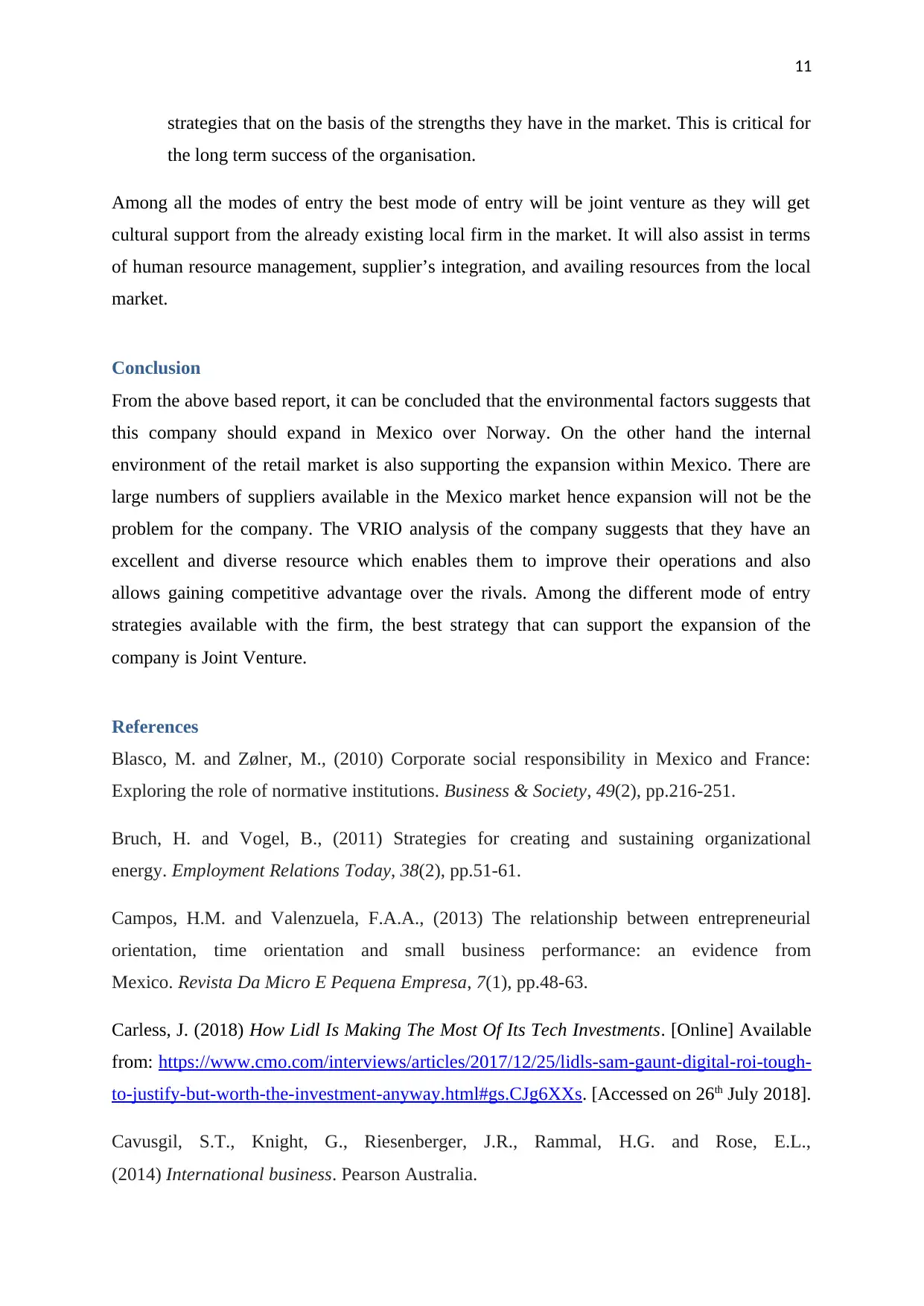
11
strategies that on the basis of the strengths they have in the market. This is critical for
the long term success of the organisation.
Among all the modes of entry the best mode of entry will be joint venture as they will get
cultural support from the already existing local firm in the market. It will also assist in terms
of human resource management, supplier’s integration, and availing resources from the local
market.
Conclusion
From the above based report, it can be concluded that the environmental factors suggests that
this company should expand in Mexico over Norway. On the other hand the internal
environment of the retail market is also supporting the expansion within Mexico. There are
large numbers of suppliers available in the Mexico market hence expansion will not be the
problem for the company. The VRIO analysis of the company suggests that they have an
excellent and diverse resource which enables them to improve their operations and also
allows gaining competitive advantage over the rivals. Among the different mode of entry
strategies available with the firm, the best strategy that can support the expansion of the
company is Joint Venture.
References
Blasco, M. and Zølner, M., (2010) Corporate social responsibility in Mexico and France:
Exploring the role of normative institutions. Business & Society, 49(2), pp.216-251.
Bruch, H. and Vogel, B., (2011) Strategies for creating and sustaining organizational
energy. Employment Relations Today, 38(2), pp.51-61.
Campos, H.M. and Valenzuela, F.A.A., (2013) The relationship between entrepreneurial
orientation, time orientation and small business performance: an evidence from
Mexico. Revista Da Micro E Pequena Empresa, 7(1), pp.48-63.
Carless, J. (2018) How Lidl Is Making The Most Of Its Tech Investments. [Online] Available
from: https://www.cmo.com/interviews/articles/2017/12/25/lidls-sam-gaunt-digital-roi-tough-
to-justify-but-worth-the-investment-anyway.html#gs.CJg6XXs. [Accessed on 26th July 2018].
Cavusgil, S.T., Knight, G., Riesenberger, J.R., Rammal, H.G. and Rose, E.L.,
(2014) International business. Pearson Australia.
strategies that on the basis of the strengths they have in the market. This is critical for
the long term success of the organisation.
Among all the modes of entry the best mode of entry will be joint venture as they will get
cultural support from the already existing local firm in the market. It will also assist in terms
of human resource management, supplier’s integration, and availing resources from the local
market.
Conclusion
From the above based report, it can be concluded that the environmental factors suggests that
this company should expand in Mexico over Norway. On the other hand the internal
environment of the retail market is also supporting the expansion within Mexico. There are
large numbers of suppliers available in the Mexico market hence expansion will not be the
problem for the company. The VRIO analysis of the company suggests that they have an
excellent and diverse resource which enables them to improve their operations and also
allows gaining competitive advantage over the rivals. Among the different mode of entry
strategies available with the firm, the best strategy that can support the expansion of the
company is Joint Venture.
References
Blasco, M. and Zølner, M., (2010) Corporate social responsibility in Mexico and France:
Exploring the role of normative institutions. Business & Society, 49(2), pp.216-251.
Bruch, H. and Vogel, B., (2011) Strategies for creating and sustaining organizational
energy. Employment Relations Today, 38(2), pp.51-61.
Campos, H.M. and Valenzuela, F.A.A., (2013) The relationship between entrepreneurial
orientation, time orientation and small business performance: an evidence from
Mexico. Revista Da Micro E Pequena Empresa, 7(1), pp.48-63.
Carless, J. (2018) How Lidl Is Making The Most Of Its Tech Investments. [Online] Available
from: https://www.cmo.com/interviews/articles/2017/12/25/lidls-sam-gaunt-digital-roi-tough-
to-justify-but-worth-the-investment-anyway.html#gs.CJg6XXs. [Accessed on 26th July 2018].
Cavusgil, S.T., Knight, G., Riesenberger, J.R., Rammal, H.G. and Rose, E.L.,
(2014) International business. Pearson Australia.
⊘ This is a preview!⊘
Do you want full access?
Subscribe today to unlock all pages.

Trusted by 1+ million students worldwide
1 out of 18
Related Documents
Your All-in-One AI-Powered Toolkit for Academic Success.
+13062052269
info@desklib.com
Available 24*7 on WhatsApp / Email
![[object Object]](/_next/static/media/star-bottom.7253800d.svg)
Unlock your academic potential
Copyright © 2020–2025 A2Z Services. All Rights Reserved. Developed and managed by ZUCOL.





